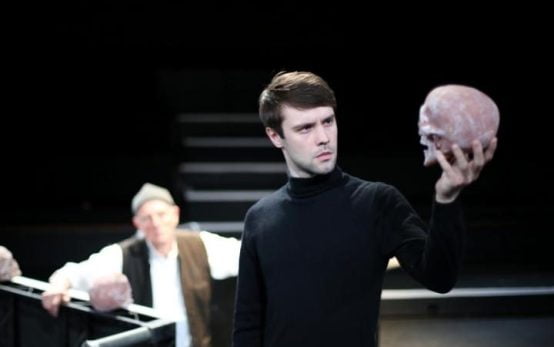
It’s all Shakespeare at the moment; inevitable, I guess. And so to the Cockpit Theatre in London, a community theatre tucked away off Lissom Grove, to see a Hamlet that we seldom see – the ‘bad quarto’ Hamlet.
There are three different surviving versions of Shakespeare’s play, much to the confusion and secret joy of editors and historians. They are generally referred to as the First Quarto, Second Quarto and First Folio versions, though there were other versions of the text which do not survive. Shakespeare wrote his play at some point between 1599 and 1602, possibly drawing on a hypothetical earlier Hamlet play (only tangential references to it survive) that may have been written by Thomas Kyd. The existence of Shakespeare’s play was first noted in the Stationer’s Register in 1602, the Register being a means of notifying the existence of a work, acting as a proto-copyright register. This didn’t work too well in terms of asserting ownership, as a pirate version – The First Quarto – appeared in 1603, which encouraged the publication of an official quarto (a quarto was a book in which the printed sheet was folded in half and then half again) in 1604, the Second Quarto. After Shakespeare’s death, his colleagues John Heminges and Henry Condell brought together a single volume of thirty-six of his plays in large-scale folio format – the First Folio – with another official version of Shakespeare’s text, in 1623.
The key to all this is that Shakespeare wrote a text that was too long for performing as it stood, and then tinkered with it. The differences between the Second Quarto and First Folio texts are fascinating for showing how small emendations significantly affected meaning, but the main point was that no one was going to put on a play that lasted over four hours. As James Shapiro notes in 1599: A Year in the Life of William Shakespeare, outdoor performances at the Globe started at two in the afternoon, so any performance in the autumn or winter months had to be over by five o’clock if the actors were still to be able to see what they were doing. When Shakespeare wrote of the “two hours’ traffic of our stage” he was being accurate.
So Hamlet, for performance, had to be cut. Whether Shakespeare did so, or whether the scissors were wielded by another’s hand, we don’t know, but what is certain is that audience’s in Shakespeare’s time did not see the text that we now revere, but a cut-down version rather more like the First, or Bad Quarto.

If that’s the case, then how come we don’t see this performance version of the play more often? Simply because it is ‘bad’. The 1603 text is a peculiar creature. Far shorter than the official versions, it has much of Shakespeare’s words but also many words that are clearly not his. The action differs in several respects, characters’ names are changed, and familiar passages are garbled. Here, for example, is the start of the ‘To be or not to be’ soliloquy (which also occurs earlier in the action than in the official texts):
To be or not to be, ay there’s the point,
To die, to sleep, is that all? Ay all:
No, to sleep, to dream, ay marry there it goes,
For in that dream of death, when we awake,
And borne before an everlasting judge,
From whence no passenger ever returned,
The undiscovered country, at whose sight
The happy smile, and the accursed damned.
The reason of the bad quarto’s badness has been hotly debated, but the commonly accepted theory is that its source was one of the actors in a touring production of Hamlet, who played the character of Marcellus (and probably other minor parts as well), since those words are recalled accurately, where as the rest is a jumble. The actor would have passed on all that he could remember to the publishers (Ling and Trundell), who hoped to capitalise on the play’s great popularity and absence of an official published text.
It would have been a prodigious feat for a minor player to recall the entire work, even in muddled form, so one suspects that other sources were used, including a playwright who would have converted the actor’s vaguer recollections into a working text. The result is a drama that broadly makes sense but profoundly lacks reason and motivation. In a way it is a bit like Tom Stoppard’s Rosencrantz and Guildenstern Are Dead, Hamlet’s world seen from the puzzled viewpoint of a minor player with only a fleeting grasp of what is actually going on.
There are other fascinating differences. Rosencrantz and Guildenstern themselves are called Rossencraft and Gilderstone. Polonius has become Cormabis (possibly to avoid offending someone whose name was close to Polonius who was associated with Oxford University, where the play was performed). Gertude becomes Gertred and is changed to become complicit in Hamlet’s plans against his uncle the King (who is not named as Claudius). Some of the changes were not due to faulty memory but to rough stagecraft – the need to fit everything in the time available. I got a strong sense of a pragmatic production (albeit a misremembered one), one that could get over the play’s essentials in a necessary two hours, well suited to taking on the road. It was the Hamlet that the players we see in Hamlet would have performed, adaptable to all occasions, not doubt playing havoc with the text as written. Shakespeare the poet probably shrank a little in horror at it; Shakespeare the businessman undoubtedly tolerated it.

Watching the First Quarto Hamlet is an intriguing exercise in memory, much as its composition was. The familiar words and actions were there, interpolated with the unfamiliar. I know Hamlet quite well, but not so well as to be able to quote more than a handful of lines before lapsing into forgetfulness, and I don’t think I was alone among the audience in struggling to work out which parts I could hear were ‘correct’ and which out of kilter. It was easy enough to spot the changes to ‘To be or not to be’, or to be taken aback at how ‘O what a rogue and peasant slave am I’ had been turned into ‘What a dunghill idiot slave am I’. But for so much else I could not with confidence vouch for whether what I heard was true, false or partly true. Some passages had obviously been hacked back by a hack (such as those relating to Gertred), but for other I lacked confidence to say what it was that I thought that I knew. The Hamlet in my head was yet another version, one composed of reading and seeing performances on stage and screen, a composite text, or memory of a text, from the viewpoint of one in the audience.
We all have our Hamlets, and none is quite like the other, because we are all located differently. One man wrote the play (though borrowing the idea from another), others adapted it, others played their different parts, and others have seen it, each in their different places in the auditorium. A text in performance flees the printed page and takes on an infinity of different lives.
The Ilissos theatre company’s production at the Cockpit Theatre of this ‘bad’ Hamlet has its weak points, but for the most part is enjoyable and engrossing. A young cast, fresh out of drama school, performs the play with vigour and conviction. I was particularly taken with Nicholas Limm’s Hamlet, a credible prince just out of adolescence, an authoritative Horatio from Christopher Laishley. The production is enlivened by some terrific contemporary blues music played between scenes, quite irrelevant to the action but so good that the programme really should have included a tracklist. Hamlet runs until 30 April, and is well worth seeing, as a lesson in authorship and memory.
Links:
- The British Library has a helpful page on the Hamlet First Quarto, with two pages reproduced (why just two?)
- The Shakespeare Quartos Archive is a cross-Atlantic digital collection of pre-1642 Shakespeare quartos, including full facsimiles of the two surviving copies of the First Quarto
- The British Library’s major exhibition, Shakespeare in Ten Acts, opens on 15 April 2016, and will have the First Quarto on display